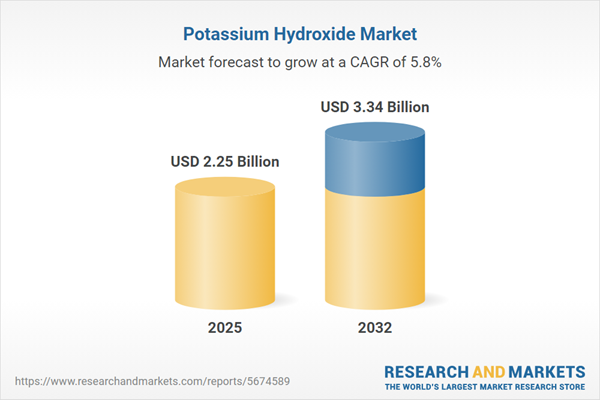Speak directly to the analyst to clarify any post sales queries you may have.
The potassium hydroxide market is experiencing significant transformation as industrial sectors adapt to new technological, regulatory, and sustainability imperatives. Senior leaders require clear, actionable intelligence to stay ahead of evolving trends and capture strategic growth opportunities in a changing global landscape.
Market Snapshot: Potassium Hydroxide Market Growth and Outlook
The Potassium Hydroxide Market grew from USD 2.12 billion in 2024 to USD 2.25 billion in 2025. It is expected to continue growing at a CAGR of 5.80%, reaching USD 3.34 billion by 2032. This expansion is powered by rising industrial consumption, process innovations, and renewed focus on downstream applications across global sectors.
Scope & Segmentation of the Potassium Hydroxide Market
- Applications: Chemical manufacturing, food processing (including chemical leavening and pH control), oil and gas, pharmaceuticals (active ingredient synthesis and final formulations), pulp and paper (bleaching and pulping), soaps and detergents (industrial and personal care), and water treatment (industrial and municipal).
- Product Types: Liquid (concentrated solution, dilute solution) and solid (flakes, pellets, powder).
- Purity Levels: Electronic grade, food grade, industrial grade, pharmaceutical grade.
- Physical Forms: Concentrated solution, flakes, pellets, powder, prills.
- Distribution Channels: Direct sales, distributors, online channels (including company websites and e-commerce marketplaces).
- Manufacturing Processes: Diaphragm cell, membrane cell, mercury cell.
- Regions Covered: Americas (North America, Latin America), Europe, Middle East & Africa (with detailed country coverage), and Asia-Pacific.
- Profiled Companies: Leaders include The Dow Chemical Company, Solvay SA, Nouryon Holding B.V., Chemtrade Logistics, Gujarat Alkalies and Chemicals, Tata Chemicals, Merck KGaA, Mitsubishi Chemical Holdings, Formosa Plastics, and OCI Company Ltd.
Key Takeaways for Senior Decision-Makers
- Technological advancements in electrochemical cell systems and automation are unlocking improvements in production efficiency, product purity, and energy savings within potassium hydroxide plants.
- Sustainability pressures and circular economy initiatives foster investments in feedstock recycling, eco-friendly manufacturing, and regulatory alignment to elevate environmental standards across the industry.
- Regional strategies are increasingly essential as the Americas focus on capacity expansion and self-reliance, while Asia-Pacific demonstrates the fastest momentum via industrialization and demand growth in the electronics value chain.
- Segment dynamics reveal diverse growth avenues from food-grade and pharmaceutical-grade offerings in Europe and specialty manufacturing in Asia, to oil and gas applications shaping demand landscapes in Latin America and the Middle East.
- Competitive positioning is reshaped through process modernization, supply chain digitalization, and localized alliances, enabling producers to differentiate on quality, responsiveness, and regulatory readiness.
Tariff Impact on the Potassium Hydroxide Sector
The recent implementation of United States tariffs on industrial chemicals, including key alkali imports, has changed procurement and production strategies. These actions prompt more reliance on domestic capacity, spurring investment in local electrolytic facilities, and driving supply chain realignment. In response, global manufacturers are exploring new distribution hubs and forging regional partnerships for long-term supply stability, while ongoing volatility prepares the market for further vertical integration and capacity shifts.
Methodology & Data Sources
This report is based on primary interviews with supply chain decision-makers and sector experts, supported by secondary research from industry publications, regulatory documents, and proprietary user surveys. Advanced scenario models and competitive frameworks, including Porter’s Five Forces, ensure comprehensive market analysis and strategic validation.
Why This Potassium Hydroxide Market Report Matters
- Enables executive teams to anticipate regulatory, technological, and supply chain changes for informed strategy planning.
- Equips stakeholders with actionable segmentation and regionally tailored opportunity analysis to optimize investment and procurement decisions.
- Clarifies evolving market dynamics and risk factors associated with global trade, innovation, and compliance mandates.
Conclusion
The potassium hydroxide market is characterized by dynamic change, regional diversity, and significant opportunities for innovation. Leaders equipped with timely market insights and well-defined strategies will secure resilient growth and sustainable competitive advantage in this evolving sector.
Additional Product Information:
- Purchase of this report includes 1 year online access with quarterly updates.
- This report can be updated on request. Please contact our Customer Experience team using the Ask a Question widget on our website.
Table of Contents
3. Executive Summary
4. Market Overview
7. Cumulative Impact of Artificial Intelligence 2025
Companies Mentioned
The companies profiled in this Potassium Hydroxide market report include:- The Dow Chemical Company
- Solvay SA
- Nouryon Holding B.V.
- Chemtrade Logistics, Inc.
- Gujarat Alkalies and Chemicals Limited
- Tata Chemicals Limited
- Merck KGaA
- Mitsubishi Chemical Holdings Corporation
- Formosa Plastics Corporation
- OCI Company Ltd.
Table Information
| Report Attribute | Details |
|---|---|
| No. of Pages | 191 |
| Published | October 2025 |
| Forecast Period | 2025 - 2032 |
| Estimated Market Value ( USD | $ 2.25 Billion |
| Forecasted Market Value ( USD | $ 3.34 Billion |
| Compound Annual Growth Rate | 5.8% |
| Regions Covered | Global |
| No. of Companies Mentioned | 11 |








